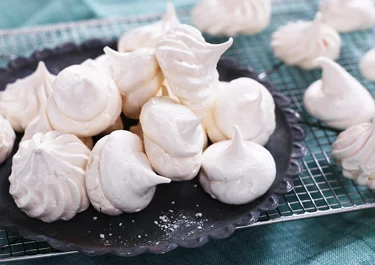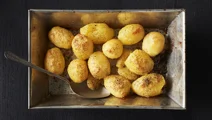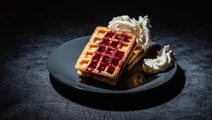Meringue

Classic meringues that can be eaten as they are or with ice cream, as a base for Pavlova or to make Eton mess with. Make sure the bowl you're whisking in is completely clean and dry before you start, otherwise the batter won't set.
Ingredients
|
4
Egg whites
|
|
|---|---|
|
2 dl
Caster sugar
|
|
|
1 tsp
Vinegar
|
Instructions
Meringue
How fast and for how long should I whisk?
To make these French-style meringues, you'll start off by beating the egg whites with an electric hand whisk or machine on medium speed until they start forming soft peaks, which should take a couple of minutes. At this point, the peaks will not be steady at all. As you add the sugar and vinegar, increase the speed and continue whisking. The peaks will gradually harden until they are able to stand firmly after the whisk is lifted: a sure sign that your meringue is ready to go on the baking sheet. Don't overwhip your meringue or it will go grainy or start to separate.
I can't get the meringue batter to form peaks! What am I doing wrong?
As simple as making meringue can be, there are factors that can sneak in to sabotage your peaks. Try to use a non-plastic mixing bowl – metal or glass – making sure that it's completely clean and dry before you start working. The reason is that any traces of fat, more easily hidden in plastic bowls, will prevent your egg white from foaming like it should. For the same reason, it's essential that not even the smallest drop of yolk ends up in the mix. Also make sure to use fresh eggs and know that cold eggs take longer to whip than eggs at room temperature.
Why add acid to meringue?
Adding an acid, in the form of lemon juice, cream of tartar, or distilled vinegar, helps to stabilise the egg whites so they form firm peaks faster. It's perfectly possible to make meringue without adding an acid – but the batter will be more prone to collapsing before the meringue is done in the oven. If you own a copper mixing bowl, you're in luck. The copper reacts with the proteins in the egg white in a way similar to the acids, so there is no need to add any acidifier. In fact, adding acid in a copper bowl will make the meringue too acidic.
What is the best way to store meringues to keep them crisp?
Meringue is essentially dried-out egg white and sugar. This means the meringue will quickly absorb humidity from the air, lose its crisp and go bad unless you store it in a dry environment. Placing the cooled meringue in an airtight container is a good way to protect it from humidity. You can store it like this at or below room temperature, out of direct sunlight, for up to two weeks. You can stack the meringues in the container, but make sure to separate the layers with parchment paper.
The difference between chewy and crumbly meringues
Meringue is always a mixture of egg white and sugar, sometimes with an added acidifier such as distilled vinegar to help harden the mix. Nevertheless, you may want a different texture in your meringue depending on where it will be used. In a pavlova, you often find meringue with a chewier centre, while something like an Eton mess tends to include meringues that are crunchy through and through. There is no great mystery here: it all depends on how long you leave them in the oven. Longer times will dry out the meringue completely, while shorter times will leave a bit of chewiness in the centre.
Learn how to pipe meringue neatly
Choose a nozzle or piping tip and start filling your piping bag with the mixture as soon as possible. If you let the meringue wait too long, it will lose its airiness and collapse. You can use a glass or a cup and draw pencil circles on the parchment paper to get even sizing on your meringues. Hold the piping bag with your dominant hand, steadied by your other hand. Try to apply even pressure on the bag, moving in steady spirals until you've filled each circle. Alternatively, start piping close to the base and move steadily upwards to get a higher meringue. Finish off each meringue with a pulling motion, to get a neat tip.








